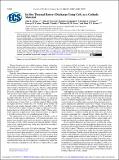Files in this item
In situ thermal battery discharge using CoS2 as a cathode material
Item metadata
| dc.contributor.author | Payne, Julia L. | |
| dc.contributor.author | Percival, Julia D. | |
| dc.contributor.author | Giagloglou, Kyriakos | |
| dc.contributor.author | Crouch, Christina | |
| dc.contributor.author | Carins, George M. | |
| dc.contributor.author | Smith, Ronald | |
| dc.contributor.author | Gover, Richard | |
| dc.contributor.author | Irvine, John T. S. | |
| dc.date.accessioned | 2019-08-05T10:30:05Z | |
| dc.date.available | 2019-08-05T10:30:05Z | |
| dc.date.issued | 2019-08-02 | |
| dc.identifier | 260342767 | |
| dc.identifier | 676dfa97-5a87-443a-a4f0-07190c41b296 | |
| dc.identifier | 85073615482 | |
| dc.identifier | 000478802900002 | |
| dc.identifier | 85073615482 | |
| dc.identifier.citation | Payne , J L , Percival , J D , Giagloglou , K , Crouch , C , Carins , G M , Smith , R , Gover , R & Irvine , J T S 2019 , ' In situ thermal battery discharge using CoS 2 as a cathode material ' , Journal of The Electrochemical Society , vol. 166 , no. 12 , pp. A2660-A2664 . https://doi.org/10.1149/2.1431912jes , https://doi.org/10.1149/2.1431912jes | en |
| dc.identifier.issn | 0013-4651 | |
| dc.identifier.other | ORCID: /0000-0003-3324-6018/work/60888224 | |
| dc.identifier.other | ORCID: /0000-0002-8394-3359/work/68280813 | |
| dc.identifier.uri | https://hdl.handle.net/10023/18246 | |
| dc.description | Authors thank AWE and the EPSRC (EP/K015540/1) for funding. JTSI acknowledges a Royal Society Wolfson Research Merit award. We thank the STFC for beam-time. | en |
| dc.description.abstract | Thermal batteries are an established primary battery technology and the most commonly used cathodes in these batteries are transition metal disulfides MS2 (where M = Co, Ni and Fe). However, understanding the evolution of crystalline phases upon battery discharge has been hindered due to the high temperature operation of these batteries. Here we report an experiment that simultaneously collects powder neutron diffraction and electrochemical data as the battery is discharged. Four regions are observed in the diffraction data and four different cobalt containing phases are observed. Multi-phase Rietveld refinement has been used to monitor the evolution of phases during discharge and this is linked to the battery discharge profile. A new discharge mechanism has been proposed which involves hexagonal CoS instead of Co3S4, and the increase in unit cell parameters on discharge suggests the formation of a sulfur deficient solid solution before transformation to Co9S8. This behavior seems reminiscent of that of NiS2 suggesting that the discharge mechanisms of transition metal disulfides may have more similarities than originally thought. | |
| dc.format.extent | 5 | |
| dc.format.extent | 829408 | |
| dc.language.iso | eng | |
| dc.relation.ispartof | Journal of The Electrochemical Society | en |
| dc.subject | Batteries | en |
| dc.subject | Energy storage | en |
| dc.subject | High temperature batteries | en |
| dc.subject | In situ | en |
| dc.subject | Neutron diffraction | en |
| dc.subject | QD Chemistry | en |
| dc.subject | Electronic, Optical and Magnetic Materials | en |
| dc.subject | Renewable Energy, Sustainability and the Environment | en |
| dc.subject | Surfaces, Coatings and Films | en |
| dc.subject | Electrochemistry | en |
| dc.subject | Materials Chemistry | en |
| dc.subject | DAS | en |
| dc.subject | SDG 7 - Affordable and Clean Energy | en |
| dc.subject.lcc | QD | en |
| dc.title | In situ thermal battery discharge using CoS2 as a cathode material | en |
| dc.type | Journal article | en |
| dc.contributor.sponsor | EPSRC | en |
| dc.contributor.sponsor | The Royal Society | en |
| dc.contributor.institution | University of St Andrews. School of Chemistry | en |
| dc.contributor.institution | University of St Andrews. Centre for Designer Quantum Materials | en |
| dc.contributor.institution | University of St Andrews. EaSTCHEM | en |
| dc.identifier.doi | 10.1149/2.1431912jes | |
| dc.description.status | Peer reviewed | en |
| dc.identifier.grantnumber | EP/K015540/1 | en |
| dc.identifier.grantnumber | WRMA 2012/R2 | en |
This item appears in the following Collection(s)
Items in the St Andrews Research Repository are protected by copyright, with all rights reserved, unless otherwise indicated.

